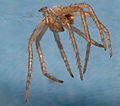Golden yellow flat spreader
| Golden yellow flat spreader | ||||||||||||
|---|---|---|---|---|---|---|---|---|---|---|---|---|

Golden yellow flat stretcher ( Philodromus aureolus ), female |
||||||||||||
| Systematics | ||||||||||||
|
||||||||||||
| Scientific name | ||||||||||||
| Philodromus aureolus | ||||||||||||
| ( Clerck , 1757) |
The golden yellow flat spider ( Philodromus aureolus ) is a spider from the family of running spiders (Philodromidae) and the most common species of this family.
features
The body length of the female is four to seven, that of the male 3.5 to five millimeters. The two sexes of the golden-yellow flat stretchers also differ in color. The female has a red to dark brown basic color. The center of the prosoma has a wide and light longitudinal band, while the flanks of the prosoma are dark. The opisthosoma of the female has an often indistinct, dark-colored and light-edged skewer spot. The drawing of the male corresponds to that of the female, but since it is darker, it appears less clearly on the dark brown basic color of the male. In addition, the male has a greenish metallic sheen all over the body, the intensity of which varies depending on the individual. Like all walking spiders, the golden-yellow flat spider has long, laterally placed legs, which make the animal an agile and fast runner. The arrangement of the eyes also corresponds to that of the other representatives of this family.
Occurrence
The widespread golden yellow flat spreader lives on the continents of Europe , Asia , Africa and North America . It inhabits various forests and bush landscapes as well as open areas and gardens and is the most common walking spider of all.
Way of life
The golden yellow flat spreader mainly inhabits the branches and foliage of trees, shrubs and herbs in its habitat. There it moves at variable speeds before it comes to an abrupt stop. Like the other running spiders, the golden yellow flat spider is a hunter who prey on other arthropods of suitable size.
Reproduction
After mating, the female erects a flat egg cocoon and attaches it to leaves or tree bark with the help of a web. The cocoon is guarded by the female until the young spiders hatch. After hatching, these develop to juvenility by autumn and look for a suitable location for wintering. The loose bark of dead trees is often preferred. It is not uncommon for several spiders to be in one location for wintering. Adult animals can be found from May to August.
Systematics
In zoology, only scientific names are valid that were assigned after the beginning of 1758, when the 10th edition of Carl von Linné's fundamental work Systema naturae appeared. An exception are some spiders, which were described by Carl Alexander Clerck in his book Svenska spindlar . One of them is the golden yellow flat spreader, which Clerck named Araneus aureolus . Charles Athanase Walckenaer divided the spiders into different families in 1805 and gave the golden yellow flat spider the name Thomisus aureolus and thus classified it among the crab spiders . In 1837 the same descriptor gave the species its name, Philodromus aureolus, which is used today .
gallery
Exuvia of a male
Individual evidence
- ↑ a b c d Heiko Bellmann: The cosmos spider guide. Over 400 species in Europe. Kosmos Naturführer, Kosmos (Franckh-Kosmos), 2nd edition, 2016, p. 256, ISBN 978-3-440-14895-2 .
- ↑ a b Description of the golden yellow flat stretcher on www.natur-in-nrw.de ( Link )
- ↑ The golden yellow flat spreader in the World Spider Catalot ( Link )









